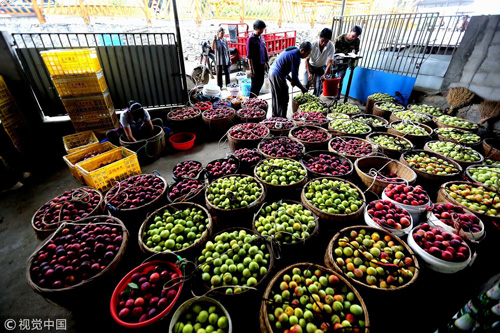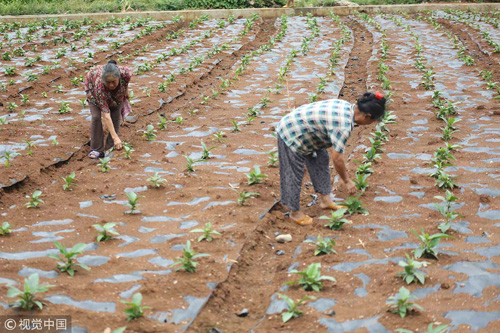Liu Yansui
Editor's note: Liu Yansui is a professor and director of the Center for Regional Agriculture and Rural Development at the Institute of Geographic Sciences and Natural Resources Research, Chinese Academy of Sciences. The article reflects the author's opinion, and not necessarily the views of CGTN.
Rural decline is a global issue. In August 2017, we published the paper entitled, “Revitalize the world’s countryside” in Nature, emphasizing that China is one of the most serious rural declining countries in the world.
In the past two decades, the inadequate rural development in China has evolved into an increasingly severe “rural diseases” with the unprecedented urbanization, showing uninhabited villages, landless villages and the consequent hollowed villages, cancer villages and poor villages.
To revitalize China’s countryside, in October 2017, Chinese President Xi Jinping at the 19th National Congress of the Communist Party of China proposed the Rural Revitalization Strategy.
 |
| A grape planting base in Wa Yaogang Village, Qutang Town, Quanzhou County, Guangxi Zhuang Autonomous Region, July 1, 2018. /VCG Photo. |
In February 2018, China released its "No. 1 Central Document" of the year entitled “Opinions on Implementing the Rural Revitalization Strategy,” which draws a roadmap for rural revitalization.
In early July, President Xi Jinping instructed the implementation of the rural revitalization strategy. He emphasized the departments of all regions should fully understand the significance of implementing the strategy, which should be put in a priority position, adhere to the five-level secretary to grasp the rural revitalization. As well as to make the rural revitalization become the common action of the whole Party and the whole society.
President Xi also pointed out that rural revitalization should realize the revitalization of rural industries, talents, culture, ecology and grass-roots organization. Revitalizing countryside must follow the law of rural development, and persist in planning ahead, promoting classification and increasing investment.
The implementation of rural revitalization strategy would help to reshape the urban-rural relationship and promote the bidirectional flow and the equal exchange of population, land, capital and other elements between urban and rural areas as well as the optimal allocation of resources.
|

|
| July 1, 2018: A fruit market in Lianghe Town, Quanzhou County, Guangxi Zhuang Autonomous Region. /VCG Photo. |
Undoubtedly, China’s countryside revitalization in the new era is a major national strategy for rural transformation and development under the problem-orientation and goal-direction.
However, the countryside is a complicated social and economic regional system. Rural development is a historical and gradual process, so rural revitalization is a systematic project, which cannot be accomplished overnight.
Rural revitalization strategy needs to break the bottleneck of rural development as the breakthrough point and make up the shortboard of rural factors as an important starting point.
It needs to scientifically grasp the differences and dynamic characteristics of rural development, optimize the pattern of regional villages and towns, solve the problems of the rural regional system, and promote the integration and development of urban and rural areas.
Thus, the overall strategic design for rural revitalization needs to be promoted by zoning, classification and graded based on the main functions, dominant types and main uses of the rural areal system.
It also needs to deepen the analysis of the process, spatial-temporal pattern and regional development model of rural transformation as well as the study on the basis of rural revitalization geography.
 |
| July 1, 2018: The villagers of Yuantou work in the field of Chinese herbal medicine “Five Fingers Peach”. /VCG Photo. |
It is necessary to establish the three-level planning system from the national to the village for rural revitalization in China.
First, the strategic plan for national rural revitalization needs to take county as a unit to carry out top-down areal zoning and county classification and put forward the related policy and deploy major projects suitable for different regions and formulate guidelines and classification guidance for provincial and municipal planning.
Second, the overall planning of rural revitalization at city and county level needs to take the village as a unit to classify villages and towns from top to bottom, connect the national and provincial rural revitalization planning and guidance, and to identify priorities for the revitalization of villages and towns, and propose the corresponding implementation plans.
Third, the detailed planning of rural revitalization for villages and towns needs to thoroughly study the orientation and tasks of rural development, clarify the spatial structure and functional blocks, and draw up a blueprint for planning and design of township construction.
 |
| July 5, 2018: Li Xiaohui (L), a technical commissioner in Lingshan Town, Jimo District, Qingdao, Shandong Province, offers technical guidance for rose tea processing. /VCG Photo. |
The rural revitalization strategy should also scientifically focus on the rural areal multi-body system. It includes urban-rural integration, rural synthesis, village-town organism and housing-industry synergy. The urban-rural integration is an important prerequisite, the rural synthesis is the fundamental basis and the village-town organism is the important carrier and support for rural revitalization.The housing-industry synergy is the advanced form of the integration of human settlements in villages and towns, which is a strategic fulcrum and an important growth pole for rural revitalization.
The essence of rural revitalization lies in the organizational reconstruction, industrial remodeling and spatial restructuring of the rural area system.
Furthermore, rural revitalization and new-type urbanization must be synergically promoted. As we pointed out in Nature last August, “villages and cities are an organism, and both should support each other”. We must adhere to the double-wheel drive strategy of ruralization and urbanization.
The integration of urban and rural areas requires the "three forces" driven by rural endogenous force, urban external support and interaction force between urban and rural areas.
Facing the globally sustainable development targets in 2030, China urgently needs to create the strategy system and institutional mechanism of rural revitalization in order to promote a scientific cognition and planning paradigm, strengthen the role of science and technology in revitalizing countryside, and promote the formation of modern “rural science” and the scientific plan of rural revitalization with Chinese characteristics. (CGTN)